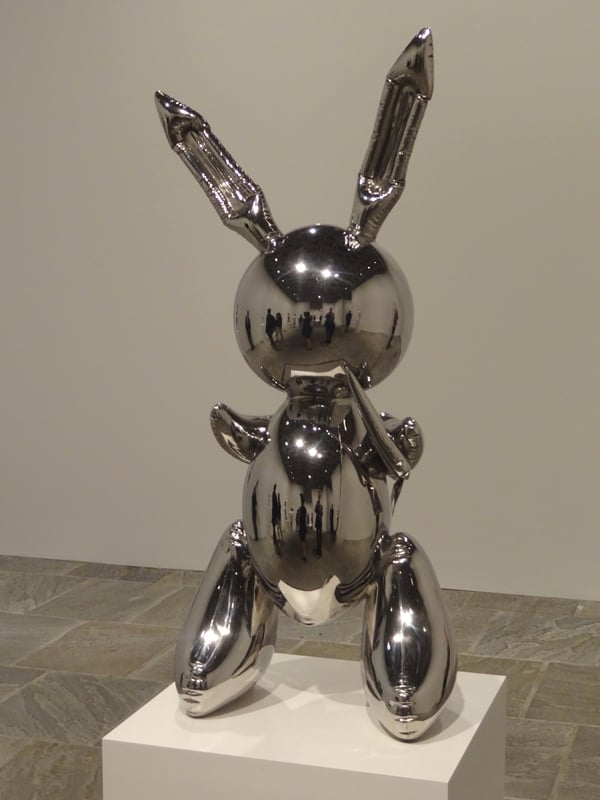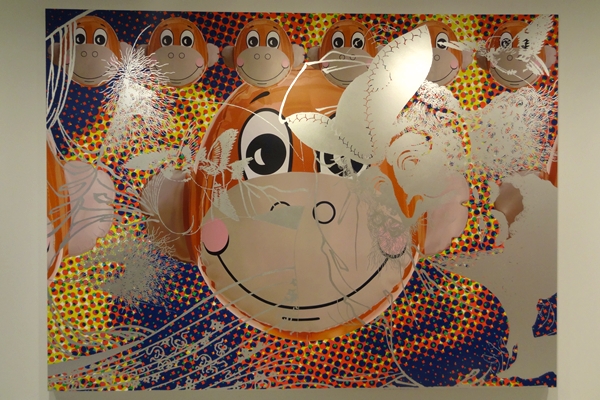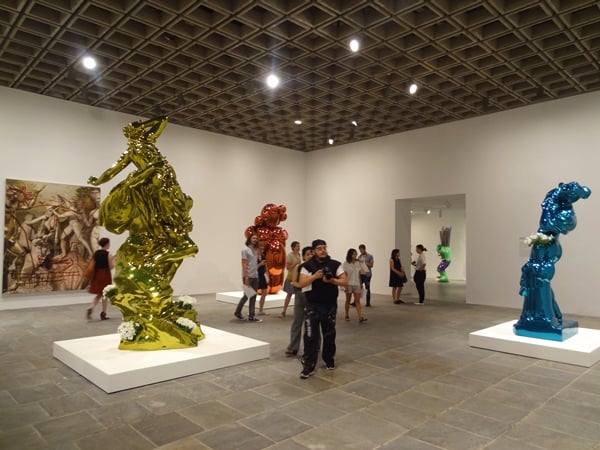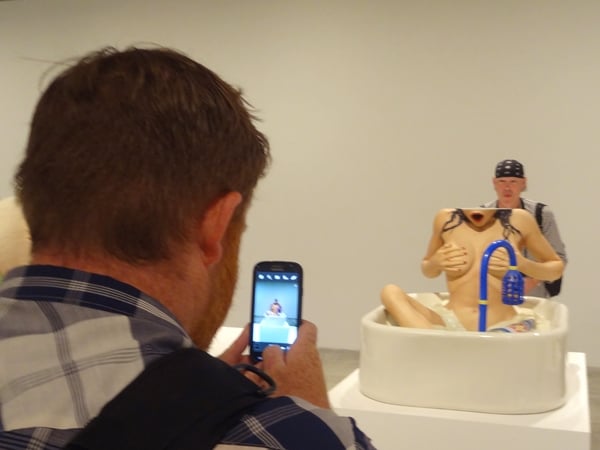Art & Exhibitions
Critical Reduction: Jeff Koons at the Whitney
What did the critics think of all that bling?

Photo: Benjamin Sutton.
What did the critics think of all that bling?

Benjamin Sutton


Jeff Koons, Dutch Couple (2007).
Photo: Benjamin Sutton
Can money buy critical immunity? It certainly seems so, judging by critics’ response to the Whitney Museum’s retrospective devoted to the most expensive living artist, Jeff Koons. In this week’s edition of Critical Reduction, we boil down eight critics’ takes on the shiny extravaganza, which, befitting of such a divisive artist, tend to be either vividly enthusiastic or vehemently dismissive. (For artnet News’s takes on the show, see Ben Davis’s review here, and Blake Gopnik and Christian Viveros-Fauné’s video review here.)
A Note on Methodology: All grades are our extrapolation of the critic’s opinion. To arrive at the final Critical Reduction Super Grade, the grade for each critic is converted (subjectively) to a number from 1 to 5; an A is worth 5, a B is worth 4, a C is worth 3, a D is worth 2, and an F is worth 1, with pluses and minuses counting as .25 more or .25 less. Those numbers are summed and divided by the number of reviews being considered (in this case, six). The resulting total is rounded up or down to the closest whole, half, or quarter number (in this case, 3.25) and assigned the corresponding letter grade.
Peter Schjeldahl, The New Yorker: B+
Schjeldahl goes back and forth as he ascends the Whitney’s four-floor retrospective, lauding certain series and writing off others. He writes that “work from the past fifteen years, following a fallow spell in the nineties, uncorks numerous marvels,” but then: “why Koons insistently produces immense paintings of montaged images beggars comprehension. They’re boring.” The grand finale, Play-Doh (1994–2014) pushes him over the edge, and firmly into the Koons Fan Klub:
A knock-out to the eye—nailing Play-Doh’s eerily super-bright but dead hues—and a goad to the mind, it might stand as an imperishable symbol of art’s present worldly estate: child’s play in a game with no-limit stakes.

Installation view of “Jeff Koons: A Retrospective.”
Photo: Benjamin Sutton.
Roberta Smith, The New York Times: A-
A startlingly glowing review. Though Smith prefaces it with a lucid account of the many things about Koons and his work that might make you squeamish, and a good deal of praise for curator Scott Rothkopf—”The depth of his fascination is apparent in his accomplished, jargon-free catalog essay, an elaborate account of Mr. Koons’s art that underscores the way it entwines with his life”—she goes on to drink the Kool-Aid by the stainless steel bucket-full:
Despite some ups and downs, this is a gripping show. It chronicles a sculptural career that is singular for its profusion of color, crafts and materials; its opening up of historical avenues closed by Minimalism; and its faith in both accessibility and advanced art, that other New. And it’s a great way for the Whitney to decamp, tossing the Met the keys, knowing that we won’t soon forget that it still owns the place.
Jerry Saltz, New York: A-
Saltz is predictably ecstatic. Though spends a paragraph dismissing Koons’s paintings, the rest of Saltz’s appraisal is cheerleading:
The Whitney’s show shocked me — by catching me completely off guard. Ingeniously organized by Scott Rothkopf to entirely bypass hysteria and spectacle, “A Retrospective” is as near to a great show of this colossally controlling artist as will be possible as long as Koons is alive.
By the time he reaches the chronological show’s conclusion, Saltz is more balloon dog than man, bouncing with excitement:
Then, in the last gallery on this floor, are three mirror-polished high-chromium-stainless-steel giant figures: the so-so sapphire Metallic Venus (2010–2012); the gigantic canary-colored remake of Bernini’s Pluto and Proserpina; and my favorite, the tangerine Balloon Venus (Orange)—Koons’s super-strange-sexy version of the Venus of Willendorf. All exist in a state of absolute-zero frozen liquidity. They are monstrosities brought to beautiful Frankenstein life.

Jeff Koons, Rabbit (1986).
Photo: Benjamin Sutton.
Christian Viveros-Fauné, The Village Voice: F
Viveros-Fauné lets loose with the zingers in his Koons pan, so much so that it’s more interesting to pull out the best jokes than any particular paragraph:
[T]he works in “A Retrospective” resemble less a curated exhibition of radical art than a grown-up’s fantasy night at FAO Schwarz.
[I]f Koons’s objects could sing, they’d belt out the “Macarena” and the SpongeBob SquarePants theme song.
Like high-fructose corn syrup, Koons’s influence is so ubiquitous that railing against it can feel futile.
In clown speak, Koons’s art is all whoopee cushion.
Thomas Micchelli, Hyperallergic: F
Micchelli is similarly alarmed by the Koons retrospective, opening in fearsome fashion:
The endgame it presents is that of a once-aspiring culture—the dream of a bold and unruly American art, symbolized by the Whitney’s audacious Marcel Breuer building—collapsing into philistinism and sentimentality, a surrender to the leveling forces of consumerism.
And then concluding scathingly:
The exhibition’s historical position as the last to fill the Breuer building is a travesty, an abdication of the museum’s responsibility to balance aesthetic discernment with the forces of the marketplace.
As the museum settles into its new, greatly expanded premises downtown, its role in the creation and presentation of art will undoubtedly evolve in unpredictable ways, but in the meantime, forget the Whitney. Art is elsewhere.

Visitors pose with Jeff Koons’s Woman in Tub (1988) at the Whitney Museum.
Photo: Benjamin Sutton.
Andrew Russeth, Gallerist: B+
Finally, the New York Observer‘s Andrew Russeth is rhapsodic for the lion’s share of his review:
He has been churning out some of the most incredible sculptures in the history of art—the balloon animals, which harbor sexual jokes; huge pool toys (lobsters, doggies) that look like inflatable plastic but are actually aluminum; shimmering copies of ancient sculptures in metal and plaster, festooned with flower pots and blue gazing balls. What he says about any of these works is invariably elaborate and meaningless, but the actual works are joys to spend a few minutes with. They’re incomparable rollercoasters for the eye…
But concludes on a comparatively sombre and sober note:
But the truth is that the artist who has long savored newness is becoming outmoded. The ground is shifting beneath his feet. Today’s most interesting artists are making objects that are incisive, scrappy, ephemeral, deliriously in flux and engaged, everything to which Mr. Koons’ work is opposed.
Jason Farago, The Guardian: C+
Farago, while finding things to like (“Banality”), ultimately focuses on how the show’s presentation of Koons falls a little flat:
[Y]ou’d have hoped we’d come further, by 2014, than to be praising someone for revealing that sometimes things aren’t what they seem, that pop culture and kitsch are omnipresent, and that the border between art and commodity can be a teensy bit slippery. For an artist who strives so mightily to convince us of his good nature, there’s something truly cruel in his sculptures’ indifference to any audience desire for profundity, complexity, or even adulthood.
Paddy Johnson, Art F City: B+
An even-keeled assessment from Johnson, ultimately falling on the side of “surprisingly good,” based on the way the show highlights the critical dimensions of the early work and her appreciation of his most recent, “Gazing Ball” series:
My reaction to curator Scott Rothkopf’s Koons retrospective—the Whitney’s final show in the Breuer Building before they move to their new building on Gansevoort—has been pretty much the opposite of outrage. I think the five-floor show does an excellent job of showcasing the implicit criticality within Koons’s early work and its subdued presence in the later work. It also reveals Koons’s obsession with fabrication, marketing, and play, which is where his virtuosity lies and often where the work fails. Reflecting on childhood may be a subject worth exploring, but monumentalizing too many feel-good toys that have bankrolled and bankrupted the artist can make an artist look either opportunistic or creepy. Koons isn’t always on the right side of that line.
The Critical Reduction Super Grade for “Jeff Koons: A Retrospective,” which continues at the Whitney Museum in New York through October 19, is a B-.